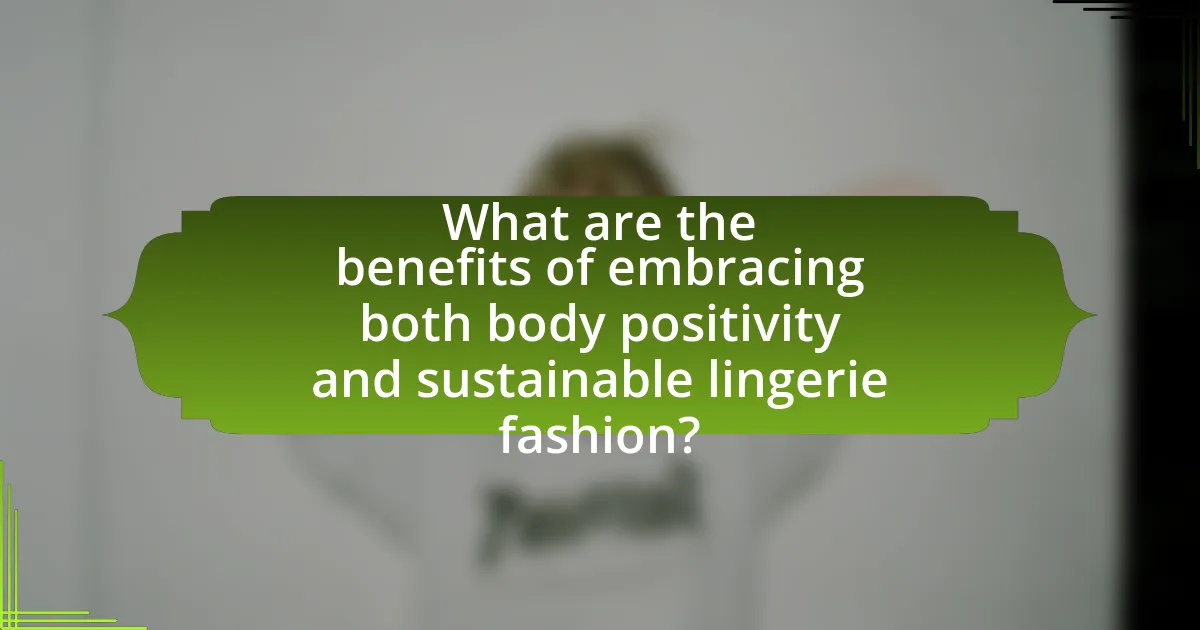The article explores the intersection of body positivity and sustainable lingerie fashion, highlighting how both movements advocate for inclusivity and ethical practices within the lingerie industry. Body positivity promotes the acceptance of diverse body shapes and sizes, while sustainable lingerie emphasizes environmentally friendly materials and ethical production processes. The article discusses the core principles of both movements, their relationship, and the challenges brands face in integrating these values. It also examines the benefits for consumers and brands, including enhanced self-esteem, environmental awareness, and market opportunities, ultimately emphasizing the importance of supporting brands that align with both body positivity and sustainability.

What is the Intersection of Body Positivity and Sustainable Lingerie Fashion?
The intersection of body positivity and sustainable lingerie fashion lies in the promotion of inclusivity and ethical practices within the lingerie industry. Body positivity advocates for the acceptance of diverse body shapes and sizes, encouraging brands to create products that cater to all individuals, rather than adhering to narrow beauty standards. Sustainable lingerie fashion emphasizes environmentally friendly materials and ethical production processes, which often align with the values of body positivity by prioritizing the well-being of both consumers and the planet. For instance, brands like Aerie and ThirdLove have successfully integrated body-positive messaging with sustainable practices, offering a range of sizes and using eco-conscious materials, thereby validating the connection between these two movements.
How do body positivity and sustainable lingerie fashion relate to each other?
Body positivity and sustainable lingerie fashion are interconnected as both movements advocate for inclusivity and ethical practices in the fashion industry. Body positivity promotes acceptance of diverse body types, encouraging brands to create lingerie that fits and flatters all shapes and sizes. Sustainable lingerie fashion, on the other hand, emphasizes environmentally friendly production methods and ethical labor practices, which align with the values of body positivity by fostering a more responsible and inclusive industry. For instance, brands that prioritize sustainability often offer a wider range of sizes and styles, ensuring that all individuals can find lingerie that suits their body while also supporting eco-friendly practices. This relationship highlights the importance of both self-acceptance and ethical consumption in modern fashion.
What are the core principles of body positivity?
The core principles of body positivity include acceptance of all body types, promoting self-love, and challenging societal beauty standards. Acceptance emphasizes that every body is unique and deserving of respect, regardless of size, shape, or appearance. Promoting self-love encourages individuals to appreciate their bodies and recognize their worth beyond physical attributes. Challenging societal beauty standards involves questioning and resisting the narrow definitions of beauty perpetuated by media and culture, advocating for inclusivity and diversity in representations of bodies. These principles collectively aim to foster a more positive and inclusive attitude towards body image, contributing to mental well-being and self-esteem.
What defines sustainable lingerie fashion?
Sustainable lingerie fashion is defined by its commitment to environmentally friendly materials, ethical production practices, and social responsibility. This includes using organic or recycled fabrics, minimizing waste through efficient manufacturing processes, and ensuring fair labor conditions for workers. For instance, brands that utilize organic cotton or recycled polyester significantly reduce their environmental impact compared to conventional materials. Additionally, ethical certifications, such as GOTS (Global Organic Textile Standard) or Fair Trade, provide proof of adherence to sustainable practices, reinforcing the integrity of sustainable lingerie fashion.
Why is the intersection of these two concepts important?
The intersection of body positivity and sustainable lingerie fashion is important because it promotes inclusivity while addressing environmental concerns. Body positivity encourages acceptance of diverse body types, which aligns with sustainable lingerie fashion that prioritizes ethical production and materials, catering to a wider range of consumers. This intersection fosters a market that values both self-acceptance and ecological responsibility, leading to a more conscious consumer base. Research indicates that brands embracing both concepts can enhance customer loyalty and satisfaction, as consumers increasingly seek products that reflect their values and promote social change.
How does body positivity influence consumer choices in lingerie?
Body positivity significantly influences consumer choices in lingerie by promoting inclusivity and diversity in body representation. This movement encourages brands to offer a wider range of sizes and styles that cater to various body types, leading consumers to prefer brands that align with their values of self-acceptance and body diversity. Research indicates that 67% of consumers are more likely to purchase from brands that feature models of different sizes and shapes, reflecting a shift towards body-inclusive marketing strategies. Consequently, lingerie brands that embrace body positivity not only enhance customer loyalty but also drive sales by appealing to a broader audience that seeks representation and affirmation in their purchasing decisions.
What role does sustainability play in the lingerie industry?
Sustainability plays a crucial role in the lingerie industry by driving the adoption of eco-friendly materials and ethical manufacturing practices. This shift is essential as the lingerie sector has historically contributed to environmental degradation through the use of synthetic fabrics and unsustainable production methods. For instance, brands are increasingly utilizing organic cotton, recycled materials, and biodegradable fabrics to reduce their ecological footprint. According to a 2021 report by the Ellen MacArthur Foundation, the fashion industry, including lingerie, is responsible for 10% of global carbon emissions, highlighting the urgent need for sustainable practices. By prioritizing sustainability, the lingerie industry not only addresses environmental concerns but also aligns with the growing consumer demand for responsible fashion choices.

What are the key challenges at the intersection of body positivity and sustainable lingerie fashion?
The key challenges at the intersection of body positivity and sustainable lingerie fashion include the difficulty in producing inclusive sizing while maintaining eco-friendly materials and practices. Many sustainable lingerie brands focus on limited size ranges, which can exclude diverse body types, undermining the body positivity movement. Additionally, the higher costs associated with sustainable materials can lead to higher retail prices, making it challenging for brands to offer affordable options for all body types. According to a report by the Ethical Fashion Forum, sustainable fashion often prioritizes environmental impact over inclusivity, creating a conflict between the two ideals.
What barriers exist for brands promoting both body positivity and sustainability?
Brands promoting both body positivity and sustainability face significant barriers, including conflicting consumer expectations and production challenges. Consumers often prioritize affordability and trendiness over sustainable practices, which can lead to a perception that sustainable products are less accessible. Additionally, the materials and processes required for sustainable lingerie can be more costly and complex, making it difficult for brands to maintain competitive pricing while also promoting inclusivity in sizing and fit. Research indicates that 66% of consumers are willing to pay more for sustainable products, yet many still gravitate towards cheaper, fast-fashion alternatives, creating a tension between ethical production and market demand.
How do societal beauty standards impact body positivity in lingerie?
Societal beauty standards significantly influence body positivity in lingerie by promoting narrow definitions of attractiveness that often exclude diverse body types. These standards, which are perpetuated by media and fashion industries, create unrealistic expectations that can lead to body dissatisfaction among individuals who do not conform to these ideals. Research indicates that exposure to idealized body images can negatively affect self-esteem and body image, as evidenced by a study published in the journal “Body Image,” which found that women exposed to thin-ideal images reported lower body satisfaction. Consequently, the lingerie market has seen a shift towards inclusivity, with brands increasingly embracing body diversity to foster body positivity, thereby challenging traditional beauty norms and encouraging acceptance of all body types.
What are the environmental challenges faced by lingerie manufacturers?
Lingerie manufacturers face several environmental challenges, primarily related to resource consumption, waste generation, and pollution. The production of lingerie often involves the use of synthetic materials like polyester, which are derived from petroleum and contribute to environmental degradation through fossil fuel extraction and greenhouse gas emissions. Additionally, the dyeing and finishing processes can release toxic chemicals into water systems, impacting aquatic life and water quality. According to a report by the Ellen MacArthur Foundation, the fashion industry, including lingerie, is responsible for 10% of global carbon emissions, highlighting the significant environmental footprint of this sector. Furthermore, the fast fashion model prevalent in lingerie production leads to increased waste, as consumers frequently discard items after minimal use, contributing to landfill overflow.
How can brands effectively address these challenges?
Brands can effectively address the challenges at the intersection of body positivity and sustainable lingerie fashion by prioritizing inclusivity in sizing and using eco-friendly materials. By offering a diverse range of sizes, brands can cater to various body types, promoting body positivity and ensuring that all consumers feel represented. For instance, brands like Aerie have successfully implemented extended sizing, which has led to increased sales and customer loyalty. Additionally, utilizing sustainable materials, such as organic cotton or recycled fabrics, not only reduces environmental impact but also appeals to the growing consumer demand for ethical fashion. Research indicates that 66% of consumers are willing to pay more for sustainable brands, highlighting the market potential for brands that align with these values.
What strategies can be implemented to promote body inclusivity?
To promote body inclusivity, brands can implement diverse representation in marketing campaigns, showcasing models of various sizes, shapes, and backgrounds. Research indicates that representation positively impacts consumer perception and self-esteem; for instance, a study published in the Journal of Consumer Research found that exposure to diverse body types can enhance body satisfaction among viewers. Additionally, brands should adopt inclusive sizing practices, ensuring that products are available in a wide range of sizes to cater to all body types. This approach not only meets consumer demand but also aligns with the growing trend towards body positivity in fashion. Furthermore, engaging in community initiatives that support body positivity, such as workshops or collaborations with body-positive influencers, can foster a more inclusive culture within the fashion industry.
How can sustainable practices be integrated into lingerie production?
Sustainable practices can be integrated into lingerie production by utilizing eco-friendly materials, implementing ethical labor practices, and adopting waste-reduction strategies. Eco-friendly materials such as organic cotton, bamboo, and recycled fabrics reduce environmental impact and resource consumption. Ethical labor practices ensure fair wages and safe working conditions, promoting social sustainability. Additionally, waste-reduction strategies, including zero-waste pattern making and recycling programs, minimize textile waste. According to a report by the Ellen MacArthur Foundation, the fashion industry could reduce its environmental footprint significantly by adopting circular economy principles, which include these sustainable practices.

What are the benefits of embracing both body positivity and sustainable lingerie fashion?
Embracing both body positivity and sustainable lingerie fashion promotes inclusivity and environmental responsibility. Body positivity encourages individuals to accept and celebrate diverse body types, fostering self-esteem and mental well-being. Sustainable lingerie fashion, on the other hand, prioritizes eco-friendly materials and ethical production practices, reducing the environmental impact of the fashion industry. Together, these movements challenge traditional beauty standards while advocating for a more sustainable future. Research indicates that brands adopting these principles see increased consumer loyalty, as 66% of consumers are willing to pay more for sustainable products, according to a Nielsen report. This alignment not only enhances brand reputation but also contributes to a healthier planet and a more accepting society.
How does this intersection benefit consumers?
The intersection of body positivity and sustainable lingerie fashion benefits consumers by promoting inclusivity and environmentally conscious choices. This combination allows consumers to find lingerie that fits diverse body types while also supporting brands that prioritize ethical production practices. For instance, brands that embrace body positivity often offer a wider range of sizes, ensuring that all individuals can find comfortable and stylish options. Additionally, sustainable lingerie brands typically use eco-friendly materials and ethical labor practices, which appeal to consumers increasingly concerned about environmental impact. Research indicates that 66% of consumers are willing to pay more for sustainable brands, highlighting the growing demand for products that align with personal values.
What positive impacts does body positivity have on self-esteem and body image?
Body positivity significantly enhances self-esteem and body image by promoting acceptance of diverse body types and challenging societal beauty standards. This acceptance fosters a healthier self-view, reducing negative self-talk and body dissatisfaction. Research indicates that individuals who embrace body positivity report higher levels of self-esteem and overall life satisfaction, as evidenced by a study published in the journal “Body Image,” which found that body-positive interventions led to improved self-acceptance and reduced anxiety related to appearance. By encouraging individuals to appreciate their bodies as they are, body positivity cultivates a more positive self-image and emotional well-being.
How does sustainable lingerie contribute to environmental awareness?
Sustainable lingerie contributes to environmental awareness by promoting eco-friendly materials and ethical production practices. This type of lingerie often utilizes organic cotton, recycled fabrics, and low-impact dyes, which reduce the environmental footprint associated with conventional textile manufacturing. For instance, the use of organic cotton can save up to 91% in water usage compared to traditional cotton farming. Additionally, brands that focus on sustainability often engage in transparent supply chains, educating consumers about the environmental impacts of their purchases. This awareness encourages consumers to make informed choices, fostering a culture of sustainability in the fashion industry.
What advantages do brands gain from this approach?
Brands gain enhanced customer loyalty and market differentiation from the approach of integrating body positivity with sustainable lingerie fashion. This strategy resonates with consumers who prioritize ethical practices and inclusivity, leading to increased brand affinity. Research indicates that 67% of consumers prefer brands that promote body positivity, which can translate into higher sales and customer retention. Additionally, aligning with sustainability trends attracts environmentally conscious shoppers, further expanding the brand’s reach and appeal.
How can brands enhance their reputation through body positivity and sustainability?
Brands can enhance their reputation through body positivity and sustainability by actively promoting inclusive sizing and environmentally friendly practices. By offering a diverse range of sizes that cater to all body types, brands demonstrate their commitment to body positivity, which can lead to increased customer loyalty and positive brand perception. For instance, a study by the Journal of Consumer Research found that brands that embrace body diversity can improve consumer trust and emotional connection.
Additionally, integrating sustainable materials and ethical production processes into their offerings reinforces a brand’s dedication to environmental responsibility. Research from the Global Fashion Agenda indicates that 66% of consumers are willing to pay more for sustainable brands, highlighting the market demand for eco-conscious practices. By aligning body positivity with sustainability, brands not only attract a broader audience but also position themselves as leaders in social responsibility, ultimately enhancing their overall reputation.
What market opportunities arise from catering to body-positive and eco-conscious consumers?
Catering to body-positive and eco-conscious consumers presents significant market opportunities, including the development of inclusive sizing and sustainable materials in lingerie. The body-positive movement emphasizes diversity in body shapes and sizes, which can lead to increased demand for brands that offer a wider range of sizes and styles, thereby capturing a larger customer base. Additionally, eco-conscious consumers prioritize sustainability, creating a market for lingerie made from organic, recycled, or biodegradable materials. According to a 2021 report by McKinsey & Company, 67% of consumers consider sustainability when making a purchase, indicating a strong market potential for brands that align with these values. By combining body positivity with eco-friendly practices, brands can differentiate themselves and foster customer loyalty, ultimately driving sales and enhancing brand reputation.
What practical steps can consumers take to support this intersection?
Consumers can support the intersection of body positivity and sustainable lingerie fashion by choosing brands that prioritize inclusivity and eco-friendly practices. By purchasing from companies that offer a wide range of sizes and promote body diversity, consumers actively contribute to a culture that values all body types. Additionally, selecting lingerie made from sustainable materials, such as organic cotton or recycled fabrics, helps reduce environmental impact. Research indicates that the global sustainable lingerie market is projected to grow significantly, reflecting increasing consumer demand for ethical fashion choices. Therefore, by supporting brands that align with these values, consumers play a crucial role in fostering both body positivity and sustainability in the lingerie industry.
How can consumers identify brands that promote body positivity and sustainability?
Consumers can identify brands that promote body positivity and sustainability by researching their marketing messages, product offerings, and corporate practices. Brands that advocate for body positivity often feature diverse models of various sizes and shapes in their advertising, emphasizing inclusivity. Additionally, these brands typically offer a wide range of sizes to cater to different body types.
Sustainability can be assessed by examining a brand’s materials, production processes, and commitment to ethical practices. Brands that prioritize sustainability often use eco-friendly materials, such as organic cotton or recycled fabrics, and implement transparent supply chains. Certifications like Global Organic Textile Standard (GOTS) or Fair Trade can also indicate a brand’s commitment to sustainable practices.
For example, brands like Aerie and Patagonia have been recognized for their body-positive campaigns and sustainable practices, showcasing their commitment to both values through their marketing and product lines.
What are some tips for choosing sustainable lingerie that aligns with body positivity values?
To choose sustainable lingerie that aligns with body positivity values, prioritize brands that use eco-friendly materials such as organic cotton, bamboo, or recycled fabrics. These materials reduce environmental impact while promoting comfort and inclusivity. Additionally, select brands that offer a wide range of sizes to ensure all body types are represented, reinforcing the body positivity movement. Look for certifications like GOTS (Global Organic Textile Standard) or OEKO-TEX, which indicate sustainable practices and safe materials. Supporting companies that promote ethical labor practices also aligns with body positivity by valuing the well-being of all individuals involved in the production process.



